Rui Qian
MANZANO: A Simple and Scalable Unified Multimodal Model with a Hybrid Vision Tokenizer
Sep 19, 2025Abstract:Unified multimodal Large Language Models (LLMs) that can both understand and generate visual content hold immense potential. However, existing open-source models often suffer from a performance trade-off between these capabilities. We present Manzano, a simple and scalable unified framework that substantially reduces this tension by coupling a hybrid image tokenizer with a well-curated training recipe. A single shared vision encoder feeds two lightweight adapters that produce continuous embeddings for image-to-text understanding and discrete tokens for text-to-image generation within a common semantic space. A unified autoregressive LLM predicts high-level semantics in the form of text and image tokens, with an auxiliary diffusion decoder subsequently translating the image tokens into pixels. The architecture, together with a unified training recipe over understanding and generation data, enables scalable joint learning of both capabilities. Manzano achieves state-of-the-art results among unified models, and is competitive with specialist models, particularly on text-rich evaluation. Our studies show minimal task conflicts and consistent gains from scaling model size, validating our design choice of a hybrid tokenizer.
STARC: See-Through-Wall Augmented Reality Framework for Human-Robot Collaboration in Emergency Response
Sep 19, 2025Abstract:In emergency response missions, first responders must navigate cluttered indoor environments where occlusions block direct line-of-sight, concealing both life-threatening hazards and victims in need of rescue. We present STARC, a see-through AR framework for human-robot collaboration that fuses mobile-robot mapping with responder-mounted LiDAR sensing. A ground robot running LiDAR-inertial odometry performs large-area exploration and 3D human detection, while helmet- or handheld-mounted LiDAR on the responder is registered to the robot's global map via relative pose estimation. This cross-LiDAR alignment enables consistent first-person projection of detected humans and their point clouds - rendered in AR with low latency - into the responder's view. By providing real-time visualization of hidden occupants and hazards, STARC enhances situational awareness and reduces operator risk. Experiments in simulation, lab setups, and tactical field trials confirm robust pose alignment, reliable detections, and stable overlays, underscoring the potential of our system for fire-fighting, disaster relief, and other safety-critical operations. Code and design will be open-sourced upon acceptance.
Energy-Constrained Navigation for Planetary Rovers under Hybrid RTG-Solar Power
Sep 18, 2025Abstract:Future planetary exploration rovers must operate for extended durations on hybrid power inputs that combine steady radioisotope thermoelectric generator (RTG) output with variable solar photovoltaic (PV) availability. While energy-aware planning has been studied for aerial and underwater robots under battery limits, few works for ground rovers explicitly model power flow or enforce instantaneous power constraints. Classical terrain-aware planners emphasize slope or traversability, and trajectory optimization methods typically focus on geometric smoothness and dynamic feasibility, neglecting energy feasibility. We present an energy-constrained trajectory planning framework that explicitly integrates physics-based models of translational, rotational, and resistive power with baseline subsystem loads, under hybrid RTG-solar input. By incorporating both cumulative energy budgets and instantaneous power constraints into SE(2)-based polynomial trajectory optimization, the method ensures trajectories that are simultaneously smooth, dynamically feasible, and power-compliant. Simulation results on lunar-like terrain show that our planner generates trajectories with peak power within 0.55 percent of the prescribed limit, while existing methods exceed limits by over 17 percent. This demonstrates a principled and practical approach to energy-aware autonomy for long-duration planetary missions.
CogStream: Context-guided Streaming Video Question Answering
Jun 12, 2025Abstract:Despite advancements in Video Large Language Models (Vid-LLMs) improving multimodal understanding, challenges persist in streaming video reasoning due to its reliance on contextual information. Existing paradigms feed all available historical contextual information into Vid-LLMs, resulting in a significant computational burden for visual data processing. Furthermore, the inclusion of irrelevant context distracts models from key details. This paper introduces a challenging task called Context-guided Streaming Video Reasoning (CogStream), which simulates real-world streaming video scenarios, requiring models to identify the most relevant historical contextual information to deduce answers for questions about the current stream. To support CogStream, we present a densely annotated dataset featuring extensive and hierarchical question-answer pairs, generated by a semi-automatic pipeline. Additionally, we present CogReasoner as a baseline model. It efficiently tackles this task by leveraging visual stream compression and historical dialogue retrieval. Extensive experiments prove the effectiveness of this method. Code will be released soon.
Seed1.5-VL Technical Report
May 11, 2025Abstract:We present Seed1.5-VL, a vision-language foundation model designed to advance general-purpose multimodal understanding and reasoning. Seed1.5-VL is composed with a 532M-parameter vision encoder and a Mixture-of-Experts (MoE) LLM of 20B active parameters. Despite its relatively compact architecture, it delivers strong performance across a wide spectrum of public VLM benchmarks and internal evaluation suites, achieving the state-of-the-art performance on 38 out of 60 public benchmarks. Moreover, in agent-centric tasks such as GUI control and gameplay, Seed1.5-VL outperforms leading multimodal systems, including OpenAI CUA and Claude 3.7. Beyond visual and video understanding, it also demonstrates strong reasoning abilities, making it particularly effective for multimodal reasoning challenges such as visual puzzles. We believe these capabilities will empower broader applications across diverse tasks. In this report, we mainly provide a comprehensive review of our experiences in building Seed1.5-VL across model design, data construction, and training at various stages, hoping that this report can inspire further research. Seed1.5-VL is now accessible at https://www.volcengine.com/ (Volcano Engine Model ID: doubao-1-5-thinking-vision-pro-250428)
FA-BARF: Frequency Adapted Bundle-Adjusting Neural Radiance Fields
Mar 15, 2025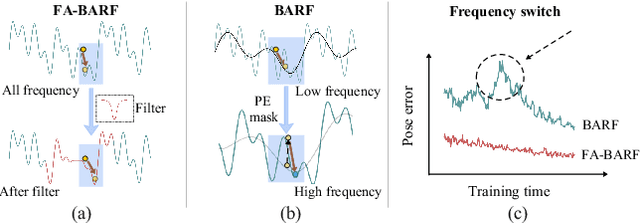

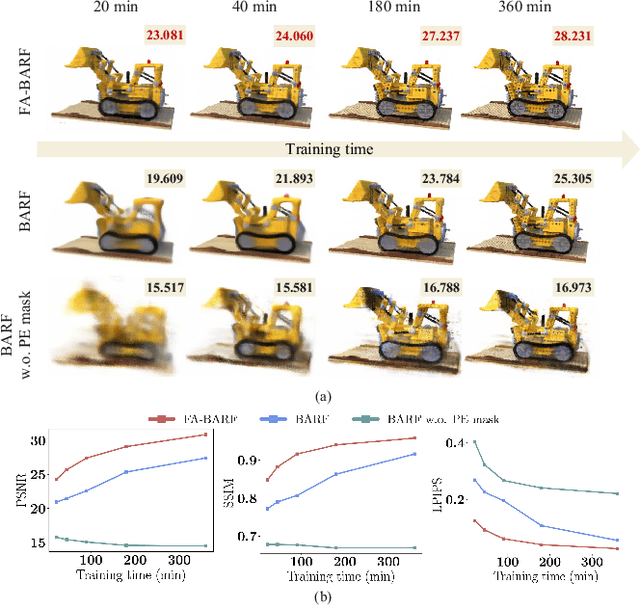
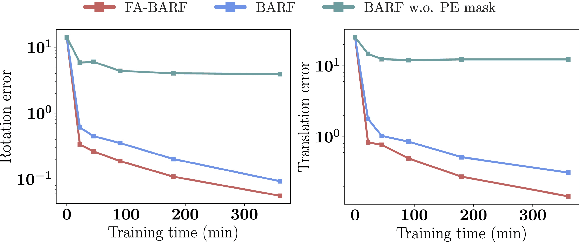
Abstract:Neural Radiance Fields (NeRF) have exhibited highly effective performance for photorealistic novel view synthesis recently. However, the key limitation it meets is the reliance on a hand-crafted frequency annealing strategy to recover 3D scenes with imperfect camera poses. The strategy exploits a temporal low-pass filter to guarantee convergence while decelerating the joint optimization of implicit scene reconstruction and camera registration. In this work, we introduce the Frequency Adapted Bundle Adjusting Radiance Field (FA-BARF), substituting the temporal low-pass filter for a frequency-adapted spatial low-pass filter to address the decelerating problem. We establish a theoretical framework to interpret the relationship between position encoding of NeRF and camera registration and show that our frequency-adapted filter can mitigate frequency fluctuation caused by the temporal filter. Furthermore, we show that applying a spatial low-pass filter in NeRF can optimize camera poses productively through radial uncertainty overlaps among various views. Extensive experiments show that FA-BARF can accelerate the joint optimization process under little perturbations in object-centric scenes and recover real-world scenes with unknown camera poses. This implies wider possibilities for NeRF applied in dense 3D mapping and reconstruction under real-time requirements. The code will be released upon paper acceptance.
DiT-Air: Revisiting the Efficiency of Diffusion Model Architecture Design in Text to Image Generation
Mar 13, 2025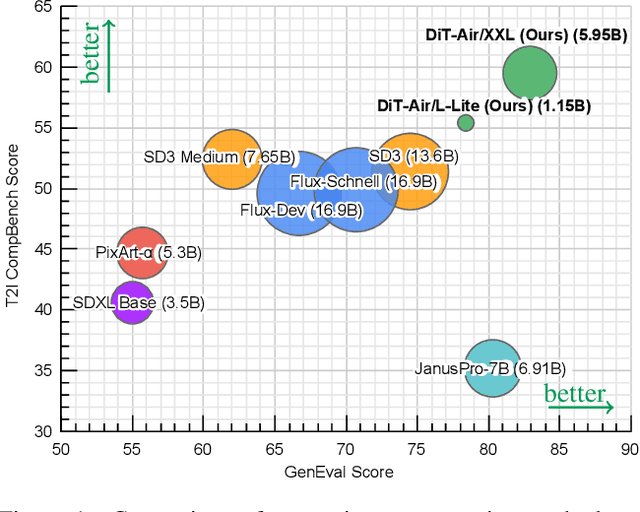



Abstract:In this work, we empirically study Diffusion Transformers (DiTs) for text-to-image generation, focusing on architectural choices, text-conditioning strategies, and training protocols. We evaluate a range of DiT-based architectures--including PixArt-style and MMDiT variants--and compare them with a standard DiT variant which directly processes concatenated text and noise inputs. Surprisingly, our findings reveal that the performance of standard DiT is comparable with those specialized models, while demonstrating superior parameter-efficiency, especially when scaled up. Leveraging the layer-wise parameter sharing strategy, we achieve a further reduction of 66% in model size compared to an MMDiT architecture, with minimal performance impact. Building on an in-depth analysis of critical components such as text encoders and Variational Auto-Encoders (VAEs), we introduce DiT-Air and DiT-Air-Lite. With supervised and reward fine-tuning, DiT-Air achieves state-of-the-art performance on GenEval and T2I CompBench, while DiT-Air-Lite remains highly competitive, surpassing most existing models despite its compact size.
DynCIM: Dynamic Curriculum for Imbalanced Multimodal Learning
Mar 09, 2025Abstract:Multimodal learning integrates complementary information from diverse modalities to enhance the decision-making process. However, the potential of multimodal collaboration remains under-exploited due to disparities in data quality and modality representation capabilities. To address this, we introduce DynCIM, a novel dynamic curriculum learning framework designed to quantify the inherent imbalances from both sample and modality perspectives. DynCIM employs a sample-level curriculum to dynamically assess each sample's difficulty according to prediction deviation, consistency, and stability, while a modality-level curriculum measures modality contributions from global and local. Furthermore, a gating-based dynamic fusion mechanism is introduced to adaptively adjust modality contributions, minimizing redundancy and optimizing fusion effectiveness. Extensive experiments on six multimodal benchmarking datasets, spanning both bimodal and trimodal scenarios, demonstrate that DynCIM consistently outperforms state-of-the-art methods. Our approach effectively mitigates modality and sample imbalances while enhancing adaptability and robustness in multimodal learning tasks. Our code is available at https://github.com/Raymond-Qiancx/DynCIM.
OVO-Bench: How Far is Your Video-LLMs from Real-World Online Video Understanding?
Jan 09, 2025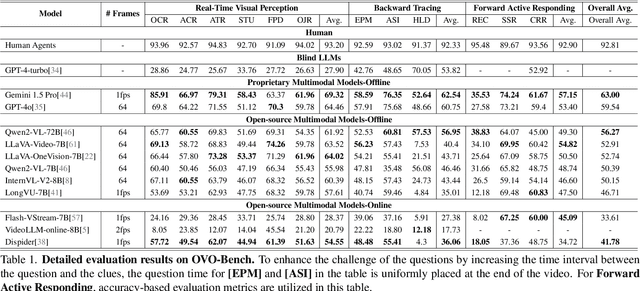
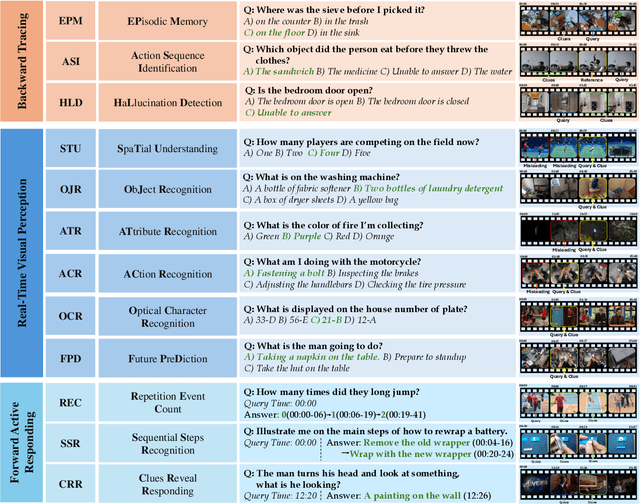
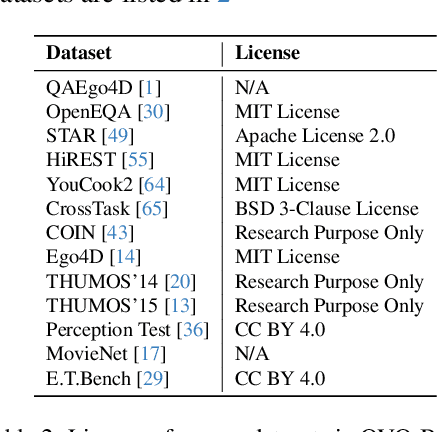
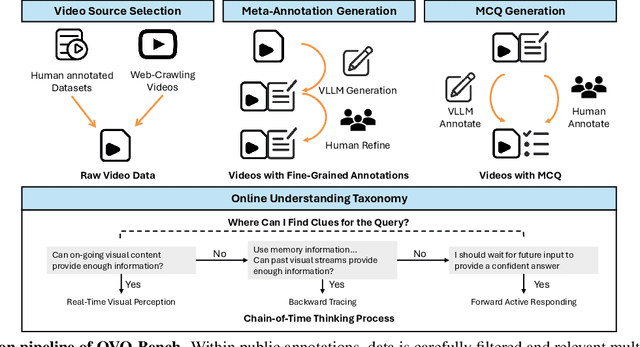
Abstract:Temporal Awareness, the ability to reason dynamically based on the timestamp when a question is raised, is the key distinction between offline and online video LLMs. Unlike offline models, which rely on complete videos for static, post hoc analysis, online models process video streams incrementally and dynamically adapt their responses based on the timestamp at which the question is posed. Despite its significance, temporal awareness has not been adequately evaluated in existing benchmarks. To fill this gap, we present OVO-Bench (Online-VideO-Benchmark), a novel video benchmark that emphasizes the importance of timestamps for advanced online video understanding capability benchmarking. OVO-Bench evaluates the ability of video LLMs to reason and respond to events occurring at specific timestamps under three distinct scenarios: (1) Backward tracing: trace back to past events to answer the question. (2) Real-time understanding: understand and respond to events as they unfold at the current timestamp. (3) Forward active responding: delay the response until sufficient future information becomes available to answer the question accurately. OVO-Bench comprises 12 tasks, featuring 644 unique videos and approximately human-curated 2,800 fine-grained meta-annotations with precise timestamps. We combine automated generation pipelines with human curation. With these high-quality samples, we further developed an evaluation pipeline to systematically query video LLMs along the video timeline. Evaluations of nine Video-LLMs reveal that, despite advancements on traditional benchmarks, current models struggle with online video understanding, showing a significant gap compared to human agents. We hope OVO-Bench will drive progress in video LLMs and inspire future research in online video reasoning. Our benchmark and code can be accessed at https://github.com/JoeLeelyf/OVO-Bench.
Dispider: Enabling Video LLMs with Active Real-Time Interaction via Disentangled Perception, Decision, and Reaction
Jan 06, 2025



Abstract:Active Real-time interaction with video LLMs introduces a new paradigm for human-computer interaction, where the model not only understands user intent but also responds while continuously processing streaming video on the fly. Unlike offline video LLMs, which analyze the entire video before answering questions, active real-time interaction requires three capabilities: 1) Perception: real-time video monitoring and interaction capturing. 2) Decision: raising proactive interaction in proper situations, 3) Reaction: continuous interaction with users. However, inherent conflicts exist among the desired capabilities. The Decision and Reaction require a contrary Perception scale and grain, and the autoregressive decoding blocks the real-time Perception and Decision during the Reaction. To unify the conflicted capabilities within a harmonious system, we present Dispider, a system that disentangles Perception, Decision, and Reaction. Dispider features a lightweight proactive streaming video processing module that tracks the video stream and identifies optimal moments for interaction. Once the interaction is triggered, an asynchronous interaction module provides detailed responses, while the processing module continues to monitor the video in the meantime. Our disentangled and asynchronous design ensures timely, contextually accurate, and computationally efficient responses, making Dispider ideal for active real-time interaction for long-duration video streams. Experiments show that Dispider not only maintains strong performance in conventional video QA tasks, but also significantly surpasses previous online models in streaming scenario responses, thereby validating the effectiveness of our architecture. The code and model are released at \url{https://github.com/Mark12Ding/Dispider}.
 Add to Chrome
Add to Chrome Add to Firefox
Add to Firefox Add to Edge
Add to Edge